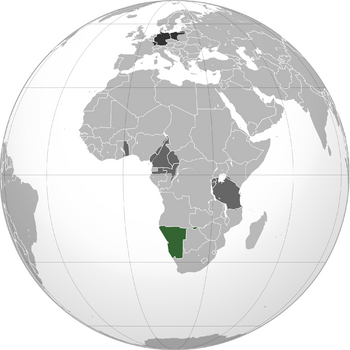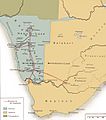German South-West Africa facts for kids
Quick facts for kids
German South West Africa
Deutsch-Südwestafrika
|
|||||||
|---|---|---|---|---|---|---|---|
| 1884–1915 | |||||||

Green: German South-West Africa
Dark Grey: Other German possessions Black: German Empire Note: The historical extent of German territories are depicted over present-day political borders. |
|||||||
| Status | German colony | ||||||
| Capital | Windhoek (from 1891) | ||||||
| Common languages | German (official), Herero, Afrikaans, Khoekhoe | ||||||
| Religion | Christianity, Saan religion | ||||||
| Governor | |||||||
|
• 1898–1905
|
Theodor von Leutwein | ||||||
|
• 1905–1907
|
Friedrich von Lindequist | ||||||
|
• 1907–1910
|
Bruno von Schuckmann | ||||||
|
• 1910–1915
|
Theodor Seitz | ||||||
| Historical era | Scramble for Africa | ||||||
|
• Established
|
7 August 1884 | ||||||
|
• Genocide
|
1904–1907 | ||||||
|
• Disestablished
|
9 July 1915 | ||||||
|
• Treaty of Versailles
|
1919 | ||||||
| Area | |||||||
| 835,100 km2 (322,400 sq mi) | |||||||
| Currency | German South West African mark | ||||||
|
|||||||
| Today part of | |||||||
German South West Africa (German: Deutsch-Südwestafrika, DSWA) was a German colony in Africa from 1884 through 1915. It is now Namibia. From 1891, the capital was Windhoek, the same city as the capital of today's Namibia. It covered an area of 835,100 km2 (322,434 sq mi). This is over one and half times the size of German Empire at the time.
Images for kids
See also
 In Spanish: África del Sudoeste Alemana para niños
In Spanish: África del Sudoeste Alemana para niños

All content from Kiddle encyclopedia articles (including the article images and facts) can be freely used under Attribution-ShareAlike license, unless stated otherwise. Cite this article:
German South-West Africa Facts for Kids. Kiddle Encyclopedia.





